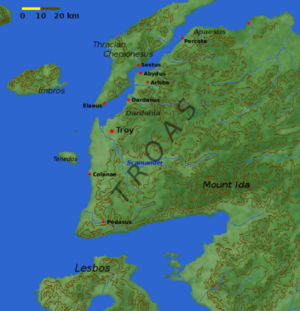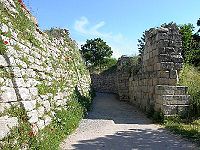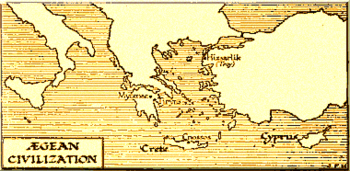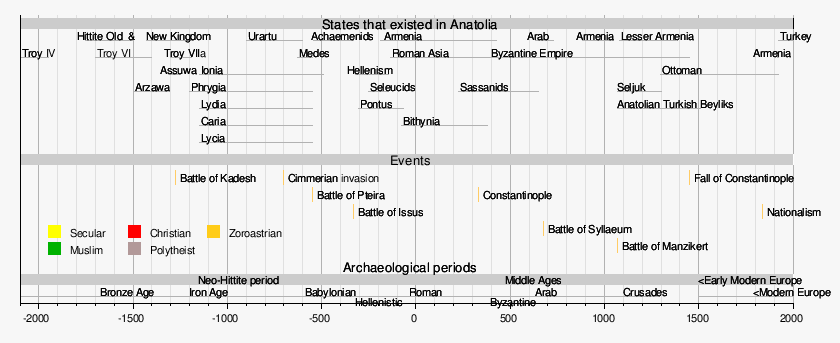Troy
| Archaeological Site of Troy* | |
|---|---|
| UNESCO World Heritage Site | |
 |
|
| State Party | |
| Type | Cultural |
| Criteria | ii, iii, vi |
| Reference | 849 |
| Region** | Europe and North America |
| Inscription history | |
| Inscription | 1998 (22nd Session) |
| * Name as inscribed on World Heritage List. ** Region as classified by UNESCO. |
|
Troy (Hittite: Wilusa or Truwisa; Greek: Ἴλιον, Ilion, and Τροία, Troia; Latin: Trōia and Īlium;[1] Turkish: Truva and Troia) was a city, both factual and legendary, located in northwest Anatolia in what is now Turkey, southeast of the Dardanelles and beside Mount Ida. It is best known for being the focus of the Trojan War described in the Greek Epic Cycle and especially in the Iliad, one of the two epic poems attributed to Homer. Metrical evidence from the Iliad and the Odyssey seems to show that the name Ἴλιον (Ilion) formerly began with a digamma: Ϝίλιον (Wilion). This was later supported by the Hittite form Wilusa.
A new city called Ilium was founded on the site in the reign of the Roman Emperor Augustus. It flourished until the establishment of Constantinople and declined gradually during the Byzantine era.
In 1865, English archaeologist Frank Calvert excavated trial trenches in a field he had bought from a local farmer at Hisarlık, and in 1868 Heinrich Schliemann, wealthy German businessman and archaeologist, also began excavating in the area after a chance meeting with Calvert in Çanakkale.[2][3] These excavations revealed several cities built in succession. Troy VII has been identified with the Hittite Wilusa, the probable origin of the Greek Ἴλιον, and is generally (but not conclusively) identified with Homeric Troy.
Today, Truva is a small Turkish city supporting the tourist trade visiting the Troia archaeological site. Troia was added to the UNESCO World Heritage list in 1998.
Contents |
Homeric Troy

Ancient Greek historians placed the Trojan War variously in our 12th, 13th, or 14th century BC: Eratosthenes to 1184 BC, Herodotus to 1250 BC, Duris of Samos to 1334 BC. Modern archaeologists associate Homeric Troy with archaeological Troy VII.[4]
In the Iliad, the Achaeans set up their camp near the mouth of the river Scamander (presumably modern Karamenderes), where they had beached their ships. The city of Troy itself stood on a hill, across the plain of Scamander, where the battles of the Trojan War took place. The site of the ancient city is some 5 km from the coast today, but the ancient mouths of alleged Scamander, some 3,000 years ago, were about that distance inland,[5] pouring into a large bay which formed a natural harbour, but has since been filled with alluvial material. Recent geological findings have permitted the reconstruction of how the original Trojan coastline would have looked, and the results largely confirm the accuracy of the Homeric geography of Troy.[6]
Besides the Iliad, there are references to Troy in the other major work attributed to Homer, the Odyssey, as well as in other ancient Greek literature. The Homeric legend of Troy was elaborated by the Roman poet Virgil in his Aeneid. The Greeks and Romans took for a fact the historicity of the Trojan War and the identity of Homeric Troy with the site in Anatolia. Alexander the Great, for example, visited the site in 334 BC and made sacrifices at tombs there associated with the Homeric heroes Achilles and Patroclus.
In November 2001, geologists John C. Kraft from the University of Delaware and John V. Luce from Trinity College, Dublin presented the results[7][8][9] of investigations, begun in 1977, into the geology of the region. They compared the present geology with the landscapes and coastal features described in the Iliad and other classical sources, notably Strabo's Geographia, and concluded that there is a regular consistency between the location of Schliemann's Troy and other locations such as the Greek camp, the geological evidence, descriptions of the topography and accounts of the battle in the Iliad. Further work by John Kraft and others was published in 2003.[10][11]
After the 1995 find of a Luwian biconvex seal at Troy VII, there has been a heated discussion over the language that was spoken in Homeric Troy. Frank Starke of the University of Tübingen recently demonstrated that the name of Priam is connected to the Luwian compound Priimuua, which means 'exceptionally courageous'.[12] "The certainty is growing that Wilusa/Troy belonged to the greater Luwian-speaking community", although it is not entirely clear whether Luwian was primarily the official language or in daily colloquial use.[13]
Archaeological Troy


The layers of ruins in the citadel at Hisarlik are numbered Troy I – Troy IX, with various subdivisions:
- Troy I 3000–2600 BC (Western Anatolian EB 1)
- Troy II 2600–2250 BC (Western Anatolian EB 2)
- Troy III 2250–2100 BC (Western Anatolian EB 3 [early])
- Troy IV 2100–1950 BC (Western Anatolian EB 3 [middle])
- Troy V: 20th–18th centuries BC (Western Anatolian EB 3 [late])
- Troy VI: 17th–15th centuries BC
- Troy VIh: late Bronze Age, 14th century BC
- Troy VIIa: ca. 1300–1190 BC, most likely setting for Homer's story[14]
- Troy VIIb1: 12th century BC
- Troy VIIb2: 11th century BC
- Troy VIIb3: until ca. 950 BC
- Troy VIII: around 700 BC
- Troy IX: Hellenistic Ilium, 1st century BC
The archaeological site of Troy was added to the UNESCO World Heritage list in 1998.
Troy I–V
The first city on the site was founded in the 3rd millennium BC. During the Bronze Age, the site seems to have been a flourishing mercantile city, since its location allowed for complete control of the Dardanelles, through which every merchant ship from the Aegean Sea heading for the Black Sea had to pass. Around 1900 BC a mass migration was set off by the Hittites to the east. Cities to east of Troy were destroyed and although Troy was not burned, the next period shows a change of culture indicating a new people had taken over Troy.[15]
Troy VI
Troy VI was destroyed around 1300 BC, probably by an earthquake. Only a single arrowhead was found in this layer, and no remains of bodies.
Troy VII
Troy VII, which has been dated to the mid- to late-13th century BC, is the most often-cited candidate for the Troy of Homer. It appears to have been destroyed by war.[16]
Troy IX

The last city on this site, Hellenistic Ilium, was founded by Romans during the reign of the emperor Augustus and was an important trading city until the establishment of Constantinople in the 4th century as the eastern capital of the Roman Empire. In Byzantine times the city declined gradually, and eventually disappeared.
Beneath part of the Roman city, the ruins of which cover a much larger area than the citadel excavated by Schliemann, recent excavations have found traces of an additional Bronze-Age settlement area (of lower status than the adjoining citadel) defended by a ditch.
Excavation campaigns
With the rise of modern critical history, Troy and the Trojan War were consigned to the realms of legend. However, the true location of ancient Troy had from classical times remained the subject of interest and speculation, so when in 1822 the Scottish journalist Charles Maclaren reviewed the available material and published A dissertation on the topography of the plain of Troy he was able to identify with confidence the position of the acropolis of Augustus's New Ilium in north-western Anatolia. In 1866 Frank Calvert, the brother of the United States' consular agent in the region, made extensive surveys and published in scholarly journals his identification of the hill of New Ilium (which was on farmland owned by his family) as the site of ancient Troy. The hill, near the town of Çanakkale, was known to the Turks as Hisarlik.[17]
Schliemann
In 1868 the German self-taught archaeologist Heinrich Schliemann visited Calvert and secured permission to excavate Hisarlık. In 1871–73 and 1878–9, he excavated the hill and discovered the ruins of a series of ancient cities dating from the Bronze Age to the Roman period. Schliemann declared one of these cities—at first Troy I, later Troy II—to be the city of Troy, and this identification was widely accepted at that time. Schliemann's finds at Hisarlik have become known as Priam's Treasure. They were acquired from him by the Berlin museums, but significant doubts about their authenticity persist.

Dörpfeld, Blegen
After Schliemann, the site was further excavated under the direction of Wilhelm Dörpfeld (1893-4) and later Carl Blegen (1932-8). These excavations have shown that there were at least nine cities built one on top of each other at this site.
Korfmann
In 1988 excavations were resumed by a team of the University of Tübingen and the University of Cincinnati under the direction of Professor Manfred Korfmann, with Professor Brian Rose overseeing Post-Bronze Age (Greek, Roman, Byzantine) excavation along the coast of the Aegean Sea at the Bay of Troy. Possible evidence of a battle was found in the form of arrowheads buried in layers dated to the early 12th century BC. The question of Troy's status in the Bronze Age world has been the subject of a sometimes acerbic debate between Korfmann and the Tübingen historian Frank Kolb in 2001/2002.
In August 1993 following a magnetic imaging survey of the fields below the fort, a deep ditch was located and excavated among the ruins of a later Greek and Roman city. Remains found in the ditch were dated to the late Bronze Age, the alleged time of Homeric Troy. It is claimed by Korfmann that the ditch may have once marked the outer defences of a much larger city than had previously been suspected. The latter city has been dated by his team to about 1250 BC, and it has been also suggested — based on recent archeological evidence uncovered by Professor Manfred Krofmann's team — that this was indeed the Homeric city of Troy.
Pernicka
In summer 2006 the excavations continued under the direction of Korfmann's colleague Ernst Pernicka, with a new digging permit.[18]
Hittite and Egyptian evidence
In the 1920s, the Swiss scholar Emil Forrer claimed that the placenames Wilusa and Taruisa found in Hittite texts should be identified with Ilium and Troia respectively. He further noted that the name of Alaksandu, a king of Wilusa mentioned in a Hittite treaty, is quite similar Homer's Paris, whose birthname was Alexandros. Subsequently, the Tawagalawa letter (CTH 181) was found to document an unnamed Hittite king's correspondence to the king of the Ahhiyawa, referring to an earlier "Wilusa episode" involving hostility on the part of the Ahhiyawa. The Hittite king was long held to be Mursili II (c.1321—1296), but since the 1980s, his son Hattusili III (1265—1240) is commonly preferred, although his other son Muwatalli (c.1296—1272) remains a possibility. Some scholars also connect Troy to the city mentioned in Hittite records as "Taruisas."[19]
Ancient Egyptian inscriptions also record a nation T-R-S as one of the "Sea Peoples" who attacked Egypt during the XIX and XX Dynasties. An inscription at Deir el-Medina records a victory of Ramesses III over the Sea Peoples, including one named "Tursha" (Egyptian: [twrš3]). It is probably the same as the earlier "Teresh" (Egyptian: [trš.w]) on the stele commemorating Merneptah's victory in a Libyan campaign around 1220 BC.
These identifications were rejected by many scholars as being improbable or at least unprovable. However, Trevor Bryce championed them in his 1998 book The Kingdom of the Hittites, citing a piece of the Manapa-Tarhunda letter referring to the kingdom of Wilusa as beyond the land of the Seha River (the classical Caicus and modern Bakırçay) and near the land of "Lazpa" (Lesbos). Recent evidence also adds weight to the theory that Wilusa is identical to archaeological Troy. Hittite texts mention a water tunnel at Wilusa, and a water tunnel excavated by Korfmann, previously thought to be Roman, has been dated to around 2600 BC. The identifications of Wilusa with Troy and of the Ahhiyawa with Homer's Achaeans remain somewhat controversial but gained enough popularity during the 1990s to be considered majority opinion.
Trojan language and script
The language of the Trojans is unknown, although several Trojan names may be identified as Luwian. The status of the so-called Trojan script is still disputable.
Troy in later legend
Such was the fame of the Epic Cycle in Roman and medieval times that it was built upon to provide a starting point for various founding myths of national origins. The most influential, Virgil's Aeneid, traces the journeys of the Trojan prince Aeneas, supposed ancestor of the founders of Rome and the Julio-Claudian dynasty. Subsequently, the heroes of Troy, both those noted in Homer and those invented for the purpose, often continued to appear in the origin stories of the nations of Early Medieval Europe.[20] The Roman de Troie was common cultural ground for European dynasties,[21] as a Trojan pedigree was both gloriously ancient and established an equality with the ruling class of Rome. A Trojan pedigree could justify the occupation of parts of Rome's former territories.[22]
Thus, the Franks filled the lacunae of their legendary origins with Trojan and pseudo-Trojan names: in Fredegar's 7th-century chronicle of Frankish history, Priam appears as the first king of the Franks.[23] The Trojan origin of France was such an established article of faith that in 1714 the learned Nicolas Fréret was Bastilled for showing through historical criticism that the Franks had been Germanic, a sore point counter to Valois and Bourbon propaganda.[24]
Similarly, Geoffrey of Monmouth reworked earlier material such as the Historia Brittonum to trace the legendary kings of the Britons from a supposed descendant of Aeneas called Brutus.
Snorri Sturluson, in the Prologue to his Prose Edda, converts several half-remembered characters from Troy into characters from Norse mythology and refers to them having made a journey across Europe towards Scandinavia, setting up kingdoms as they went.
A small minority of contemporary writers argue that Homeric Troy was not in Anatolia, but located elsewhere: England,[25] Croatia, and Scandinavia have been proposed. These theories have not been accepted by mainstream scholars.
Tourism
A Turkish town called Truva has recently grown up in the vicinity of the archaeological site to service the tourist trade. The archaeological site is officially called Troia by the Turkish government and appears as such on many maps. A large number of tourists visit the site each year, mostly coming from Istanbul by bus or ferry via Çanakkale, the nearest major town. The visitor sees a highly commercialised site, with a large wooden horse built as a playground for children, shops, and a museum. The archaeological site itself is, as a recent writer said, "a ruin of a ruin," because the site has been frequently excavated and because Schliemann's archaeological methods were very destructive: in his conviction that the city of Priam would be found in the earliest layers, he demolished many interesting structures from later ones, including all of the house walls from Troy II. For many years, the site was also unguarded and was thoroughly looted.
Notes
- ↑ Trōia is the typical Latin name for the city. Ilium is a more poetic term: Lewis, Charlton T.; Charles Short. "Ilium". A Latin Dictionary. Tufts University: The Perseus Digital Library. http://www.perseus.tufts.edu/cgi-bin/ptext?layout.reflang=la;layout.refdoc=Perseus%3Atext%3A1999.04.0059;layout.reflookup=Ilium;layout.refcit=;doc=Perseus%3Atext%3A1999.04.0059%3Aentry%3D%2321459. Retrieved 2008-03-01.
- ↑ Wood, Michael (1985). In Search of the Trojan War. London: British Broadcasting Corporation. pp. 54–55. ISBN 9780563201618.
- ↑ Aşkin, Mustafa (1981). Troy (2005 rev ed.). Istanbul: Keskin. p. 34. ISBN 975-7559-37-7.
- ↑ Wood (1985:16)
- ↑ Strabo, Geography XIII, I, 36, tr. H. L. Jones, Loeb Classical Library; Pliny, Natural History, V.33, tr. H. Rackham, W. S. Jones and D. E. Eichholz, Loeb Classical Library.
- ↑ Geologists investigate Trojan battlefield, 7 February 2003, BBC NEWS
- ↑ Confex.
- ↑ Nature.
- ↑ Iliad, Discovery.
- ↑ Harbor areas at ancient Troy: Sedimentology and geomorphology complement Homer's Iliad, Geoscience World (abstract)
- ↑ Press Release: Geology corresponds with Homer’s description of ancient Troy University of Delaware
- ↑ Starke, Frank. "Troia im Kontext des historisch-politischen und sprachlichen Umfeldes Kleinasiens im 2. Jahrtausend". // Studia Troica, 1997, 7, 447-87.
- ↑ Latacz, Joachim (2004). Troy and Homer: Towards a Solution of an Old Mystery, page 116. Oxford. ISBN 9601615571.
- ↑ Troy VII and the Historicity of the Trojan War, Dartmouth College (2000)- accessed 2007-03-17
- ↑ Mellaart, James (January 1958). "The end of the early Bronze Age in Anatolia and the Aegean". American Journal of Archaeology 62 (1): 9–33. doi:10.2307/500459. http://www.jstor.org/stable/500459. Retrieved 2009-09-14.
- ↑ http://projectsx.dartmouth.edu/history/bronze_age/lessons/les/27.html Troy VII and the Historicity of the Trojan War
- ↑ Wood (1985: 42—44)
- ↑ Universität Tübingen setzt Ausgrabungen in Troia fort.
- ↑ Carter-Morris, p. 34–35.
- ↑ Huppert, George. "The Trojan Franks and their Critics." Studies in the Renaissance 12. 1965. pp. 227-241. & Hays, Denys. Europe: The Emergence of an Idea. 1957.
- ↑ A. Joly first traced the career of the Roman de Troie in Benoit de Sainte-More et le Roman de Troie (Paris 1871).
- ↑ Huppert, supra.
- ↑ Exinde origo Francorum fuit. Priamo primo rege habuerant.
- ↑ Larousse du XIXe siècle sub "Fréret", noted by Huppert 1965.
- ↑ Iman Wilkens, Where Troy Once Stood, (Groningen 2005), p. 68.
References and further reading
- Carter, Jane Burr; Morris, Sarah P. The Ages of Homer. University of Texas Press, 1995. ISBN 0292712081.
- Easton, D.F.; Hawkins, J.D.; Sherratt, A.G.; Sherratt, E.S. "Troy in Recent Perspective", Anatolian Studies, Issue 52. (2002), pp. 75–109.
- Latacz, Joachim (2004). Troy and Homer: towards a solution of an old mystery. Oxford: Oxford University Press. ISBN 0199263086
- Fantasies of Troy: Classical Tales and the Social Imaginary in Medieval and Early Modern Europe, edited by Alan Shepard and Stephen D. Powell. Toronto: Centre for Reformation and Renaissance Studies, 2004.
- Ilios. The city and country of the Trojans: the results of researches and discoveries on the site of Troy and through the Troad in the years 1871-72-73-78-79; (searchable facsimile at the University of Georgia Libraries, requires dejavu-plugin)
- Farnham Bishop and Arthur Gilchrist Brodeur wrote a novel, In the Grip of the Minotaur which was serialized in Adventure magazine in 1916. Set around 1400 B.C., it tells the story of a group of Northmen who visit the ancient Mediterranean on a trading mission and become embroiled in intrigues between the rising power of Troy and the mistress of the Mediterranean, Crete—the latter then ruled by King Minos. Brodeur was a professor at Berkeley who translated The Prose Eddas by Snorri Sturluson and was a well-known Beowulf scholar. The novel has recently been printed in book form for the first time. (2010) ISBN 978-1-928619-98-7 by [1].
External links
- General
- Troy on the Internet Educational website, University of Cincinnati
- Archaeology
- Geography
- Geology corresponds with Homer’s description of ancient Troy, article by Neil Thomas on the University of Delaware site.
|
|||||
|
|||||
|
|||||||||||||||||||||||
|
|||||||||||||||||||||||
|
||||||||
|
|||||
